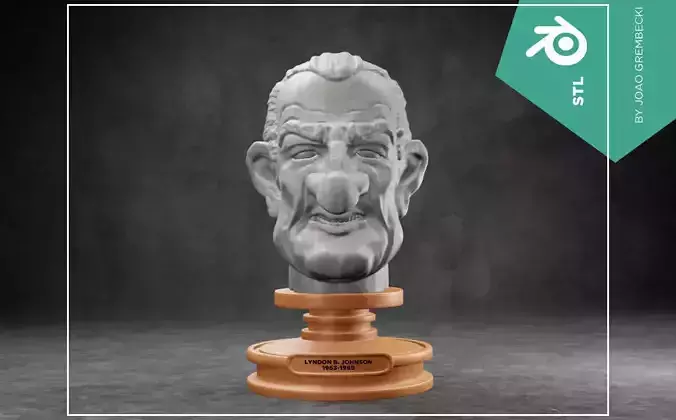1/13
This is a Caricature of Lyndon B Johnson, democrat president of the US between 1963 and 1969.
This caricature is part of a series with all US presidents from 1961 to 2021.
This is a 3D model, which you can print in one shade.
Parts are:
- Head
- Pedestal for support
Archives on Stereolithography (.stl) (2files), Object (.obj) (2 files) and a Blender project.
Lyndon Baines Johnson, often referred to by his initials LBJ, was the 36th president of the United States, serving from 1963 to 1969. He had previously served as the 37th vice president from 1961 to 1963 under President John F. Kennedy. A Democrat from Texas, Johnson also served as a U.S. representative, U.S. senator and the Senate's majority leader. He holds the distinction of being one of the few presidents who served in all elected offices at the federal level.
Born in a farmhouse in Stonewall, Texas to a local political family, Johnson worked as a high school teacher and a congressional aide before winning election to the U.S. House of Representatives in 1937. He won election to the United States Senate from Texas in 1948 after narrowly winning the Democratic Party's nomination. He was appointed to the position of Senate Majority Whip in 1951. He became the Senate Democratic leader in 1953 and majority leader in 1954. In 1960 Johnson ran for the Democratic nomination for president. During the convention he came into conflict with the Democratic front-runner, fellow senator John F. Kennedy. The two men compromised and the Kennedy-Johnson ticket won in the 1960 presidential election. Vice President Johnson would assume the presidency on November 22, 1963 after President Kennedy was assassinated. The following year Johnson was elected to the presidency when he won in a landslide against Arizona Senator Barry Goldwater. Johnson received 61.1% of the popular vote in the 1964 presidential election; this makes his victory the largest share of the popular vote of any candidate since James Monroe's victory in 1820.
Johnson's domestic policy was aimed to create programs that would expand civil rights, public broadcasting, Medicare, Medicaid, aid to education and the arts, urban and rural development, and public services. Johnson coined the term the Great Society in 1964 to describe these efforts. In addition, he sought to create better living conditions for low income Americans by spearheading a campaign unofficially called the War on Poverty; assisted by a strong economy, the effort helped millions of Americans rise above the poverty line during his administration. Johnson followed his predecessor's actions in bolstering the space program, and it was under his presidency that NASA's efforts became a top national priority and the Apollo Program was expanded. He enacted the Higher Education Act of 1965 which established federally insured student loans. Johnson signed the Immigration and Nationality Act of 1965 which laid the groundwork for U.S. immigration policy today. Johnson's opinion on the issue of civil rights put him at odds with other white, southern Democrats. His civil rights legacy was shaped by signing the Civil Rights Act of 1964, the Voting Rights Act of 1965, and the Civil Rights Act of 1968. During his presidency the American political landscape transformed significantly, as white southerners who were Democratic stalwarts gradually moved to the Republican Party and African-Americans began moving towards the Democratic Party. Because of his domestic agenda, Johnson's presidency marked the peak of modern liberalism in the United States.
Johnson's presidency took place in Cold War America and thus he prioritized halting the expansion of Marxist-Leninist governments. Prior to 1964, the U.S. already had a noticeable presence in Vietnam by providing weapons, training, and aid to South Vietnam in order to stem the communist movement in the region. In 1964, following a naval skirmish, Congress passed the Gulf of Tonkin Resolution, which granted Johnson the power to launch a full military campaign in Southeast Asia, marking the escalation of American involvement in the Vietnam War. The number of American military personnel in Vietnam increased dramatically, and as the war progressed, American casualties soared along with deaths of Vietnamese civilians. In 1968, the Tet Offensive inflamed the anti-war movement and public opinion dramatically turned against the war. Many called an end to U.S. involvement, and opposition to the war surged among draft-age students on university campuses.
REVIEWS & COMMENTS
accuracy, and usability.













